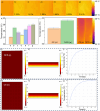Lotus leaf-inspired thermal insulation and anti-icing topography
- PMID: 38863814
- PMCID: PMC11166188
- DOI: 10.1039/d4ra02843k
Lotus leaf-inspired thermal insulation and anti-icing topography
Abstract
Porous sandwich-like structures with surface roughness possess the capacity to sustain droplets, diminish the area of contact between solids and liquids, and augment heat conductivity, and thus delay ice formation when the temperature drops below the freezing point. The prevalence of this combination of surface roughness and a hollow sandwich structure has been observed in several organisms, such as lotus leaves, which have developed these features as a result of environmental adaptation. This study introduces a new design for a surface consisting of a micro-nano conical array and a foam structure with a gradient of pores. The primary components of this design were isocyanate and polyether. The hollow gradient sandwich structure was created by manipulating the water content to increase the porosity, resulting in the formation of a conical-pit morphology on the underside of the specimen. This configuration significantly decreased the amount of heat lost and the modulus of elasticity of the sample. Additionally, the micro-nano hydrophobic structure on the upper surface hindered the transmission of temperature and delayed the formation of ice. This concept, inspired by natural structures, has significant potential applications in the areas of anti-icing, energy conservation, and environmental preservation.
This journal is © The Royal Society of Chemistry.
Conflict of interest statement
There are no conflicts to declare.
Figures







Similar articles
-
Robust Stick-and-Play Photothermal Icephobic Film with Bioinspired Insulation Cells.Adv Sci (Weinh). 2025 May;12(18):e2502687. doi: 10.1002/advs.202502687. Epub 2025 Mar 16. Adv Sci (Weinh). 2025. PMID: 40091403 Free PMC article.
-
Robust and Superhydrophobic Polydimethylsiloxane/Ni@Ti3C2Tx Nanocomposite Coatings with Assembled Eyelash-Like Microstructure Array: A New Approach for Effective Passive Anti-Icing and Active Photothermal Deicing.ACS Appl Mater Interfaces. 2024 May 22;16(20):26713-26732. doi: 10.1021/acsami.4c01561. Epub 2024 May 9. ACS Appl Mater Interfaces. 2024. PMID: 38723291
-
Photothermal and Hydrophobic Surfaces with Nano-Micro Structure: Fabrication and Their Anti-Icing Properties.Nanomaterials (Basel). 2025 Feb 28;15(5):378. doi: 10.3390/nano15050378. Nanomaterials (Basel). 2025. PMID: 40072181 Free PMC article. Review.
-
Nature inspired structured surfaces for biomedical applications.Curr Med Chem. 2011;18(22):3367-75. doi: 10.2174/092986711796504673. Curr Med Chem. 2011. PMID: 21728964 Review.
-
Mechanism of self-recovery of hydrophobicity after surface damage of lotus leaf.Plant Methods. 2024 Mar 21;20(1):47. doi: 10.1186/s13007-024-01174-7. Plant Methods. 2024. PMID: 38515129 Free PMC article.
References
-
- Ruy A. Marilene G. Ires P. Constr. Build. Mater. 2017;146:38.
-
- Federica B. Paolo B. Sara C. Serena G. Laura M. V. Adv. Eng. Mater. 2022:1438.
-
- Silva E. C. N. Walters M. C. Paulino G. H. J. Mater. Sci. 2006;41:4991.
-
- Nogata F. Takahashi H. Composites, Part B. 1995;5:743.
-
- Faisal T. R. Abad E. M. K. Hristozov N. Pasini D. J. Bionic Eng. 2010;7:S11.
LinkOut - more resources
Full Text Sources

